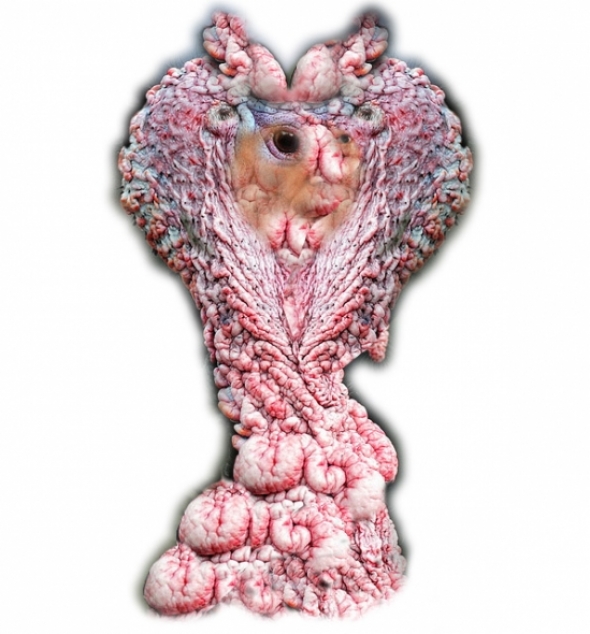Bruce Willis, Irigaray, and the Aesthetics of Space Travel
'Or for instance, if you were crushed to death by hundreds of boxes of chocolate....' John Russell takes the (w)hole system apart and refuses to put it back together again…
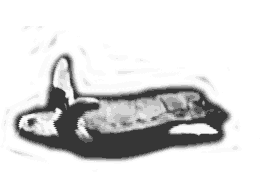
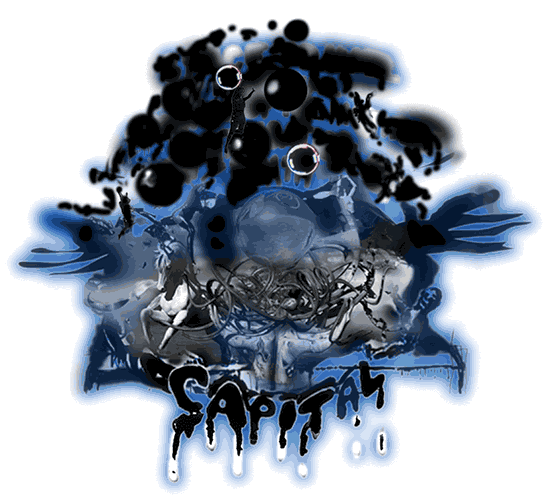

In his essay ‘The Pineal Eye’ Georges Bataille describes a giant gibbon aiming her anus at the sky, buried upside down, trussed up like a chicken, with her legs folded back against her body, ‘… her bestially howling mouth swallowing dirt’ while, at the other end, ‘her huge screaming pink anal protrusion stares at the sky like a flower’. A stake runs between her belly and her bound paws and ‘only the part whose obscenity stupefies emerges above the top level of the pit’. After her captors have filled the pit with dirt the gibbon’s anus is described as even more upsetting to see when touched by the ‘pretty white fingers’ of the English woman.[1]


Emerging from Freud’s libidinal semiotics, Irigaray describes how bodies coded in castration are organised into an economy of representation based around the ultimate symbolic value of the penis or phallus. A brutal visual (or as Irigaray puts it ‘specular’) dialectic of 'have' or 'have not' where the patriarchal structure cannot make sense of the ‘Little Girl’ except as a 'little man’ with an inadequate penis;[2] prioritising the masculine and phallic in contrast to the feminine and vaginal (as ‘lack’ or ‘other,’ structured as an absence which proves masculine presence). The relation of MAN to NOT-MAN (woman) which pre-scripts us all.[3]


The problem of sexual difference then (for forthcoming cosmonauts) is a problem of ‘sameness’ where the ‘feminine’ can only register as 'difference' in the format of 'difference from' the dominant term (difference from the ‘same’). And in this context, specularity is a structure which excludes (the unseen) but validates the seen or seeable. To quote Irigaray: ‘… the flat mirror reflects the greater part of women’s sexual organs only as a hole. And the eye does the same, unless it gets “inside”’ and here she references Georges Bataille’s ‘Story of the Eye’. Women cannot appear reflected in this flat mirror, but can only be thought of as the components of which the mirror is made, the tain of the mirror (the reflective backing).[4]
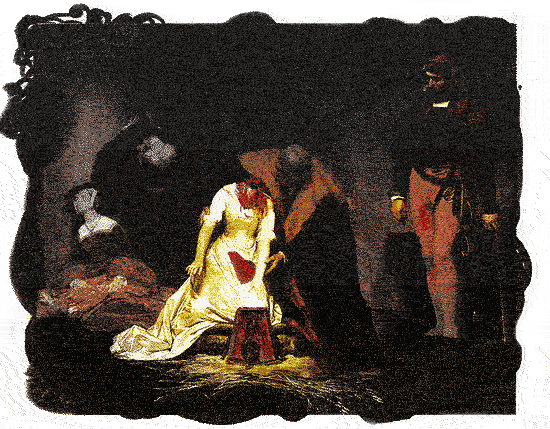

Sliced off with blood spurting out of your neck-hole. Swaying slightly. A comforting hand on your shoulder from the blond man on the right. His head twisting around and across to make sure you are OK. The scalpel stands at the side – looking down.
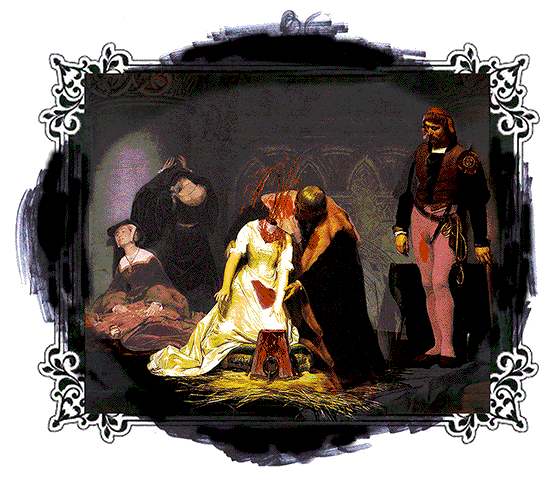
The penis, sliced down the middle, fat and muscle removed, sways upright supported by calipers (from a video documenting the transformation of a penis into a vagina).[5] The servants in the background collapse against the wall, their dresses splattered with blood. The skin is loosened from the flesh and folded round. And then miraculously wrapped inside, the penis head now becomes the clitoris.
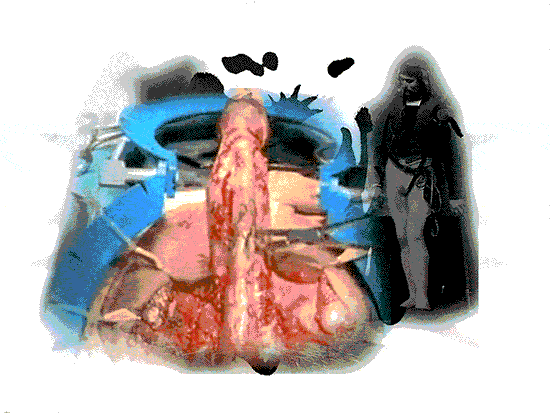
Ejaculating out his penis-hole – but barefooted – the terrorists have shot out the partition windows – Bruce Willis must take care not to cut the flesh on the underside of his feet on the broken glass strewn around the office. Swaying there like a penis with the fat cut off, he remembers he used to specialise in comedy-action movies where he could deploy his rugged good looks as the lovable but flawed good guy (with sex potential). For instance, in the Moonlighting TV series (1985-9), as John McCane in the first two Die Hard films (1988 and 1990), or even as the washed up boxer in Pulp Fiction (1994).
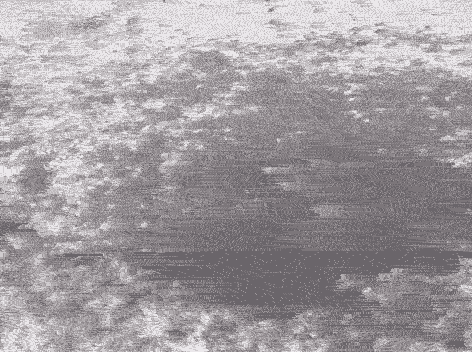

An ant ‘death spiral’ is where ants (sometimes millions of ants) get separated from the main swarm and end up following each other's scent in a ‘circular mill’ until they are exhausted and die. Films of this phenomenon are posted on YouTube, often accompanied by William Beebe’s eyewitness account of an example in Guyana in 1921. Measuring 1,200 feet in circumference, with a 2 hour circuit time per ant, the mill persisted for two days, ‘with ever increasing numbers of dead bodies littering the route, as exhaustion took its toll. But eventually a few workers straggled from the trail thus breaking the cycle, and the raid marched off into the forest.’[6]
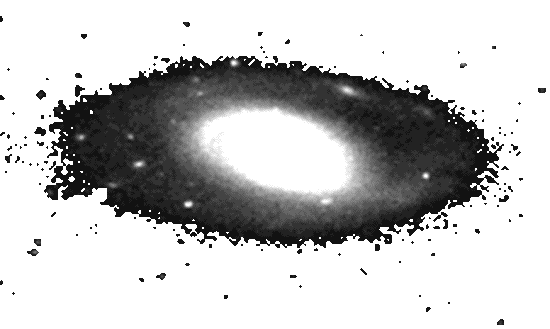
This metaphor crudely expresses, in the structure of a joke (or trap), the integration of our temporary life-spans into the strategies and circulations of capital (and its genetics) as the finite expenditure of labor power, chopped up into small circuits of work and pay, repeated again and again (and our dependence upon this repetition) until death.
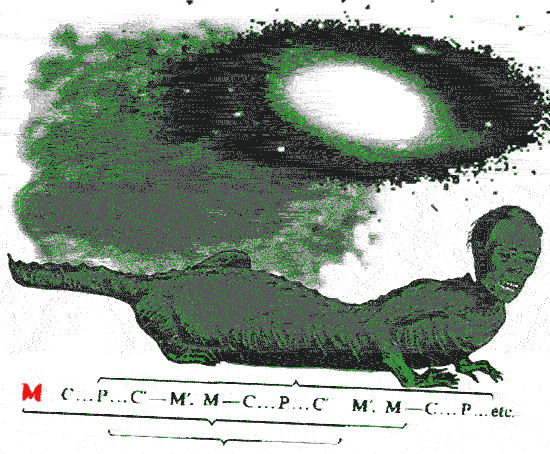
This is replayed, in ideology, as a cosmic melodrama of circulation, where the brutal cycles of labor and wage are contrasted against the cool “infinity” of M-C-M, expressed in the ‘etc.’ of Marx’s formula and lined up with the ‘Unlimited’ of the Universe and 'Nature' (as Bruce Willis describes it in his Sky Broadband advert).[7]

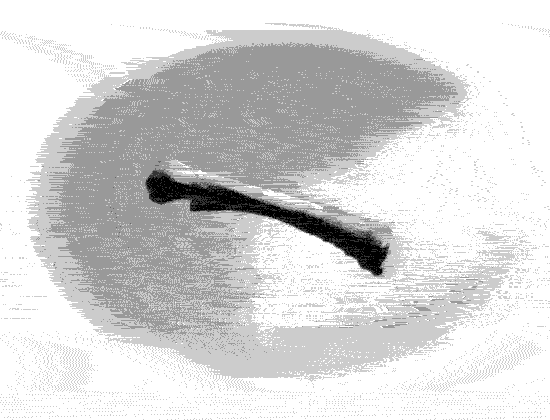
The banal stretched across the glamour of Time like a castrated penis wrapped in cling-film or Kubrick’s match cut from caveman to space travel (and back to KFC bone) and so on.[8] Space travel as escape from the limited and the terrestrial, measured out against the trivial carnality of our own petty materialities, 'until the last syllable of recorded time' and so on. As Benedict Singleton writes ‘the characteristic gesture of cosmism, what we might call the “cosmist impulse”, [is] to consider the earth a trap, and to understand the common project of philosophy, economics, and design as being the formulation of means to escape from it’.[9] To escape the banal-terrestrial like angels.
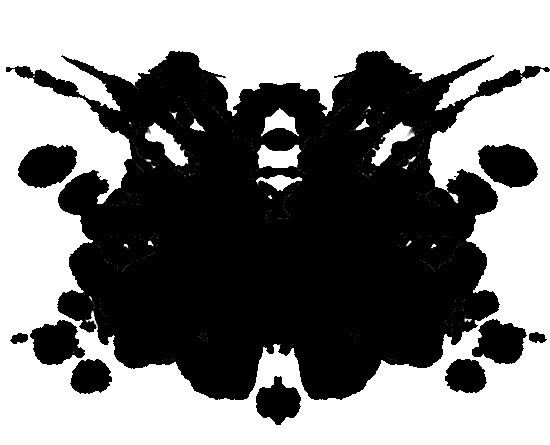

More recently in films like Sin City (2005), Die Hard IV (2007) and Fire with Fire (2012) Willis has been recast as a father-figure decoy phallus and/or Grandpa reverse-fuck figure, counterpointed against the ‘younger female lead’ and based on the premise of reverse-potency, that is, the unstated but implicit promise that: ‘If I was forty years younger I would [be able to] fuck you [in a nice way]’. This is a similar format to many Hollywood films and TV series where the male lead plays the Grandfather role, always meeting young female leads who he would have fucked in the past, subject to Hollywood laws of oedipal propriety.
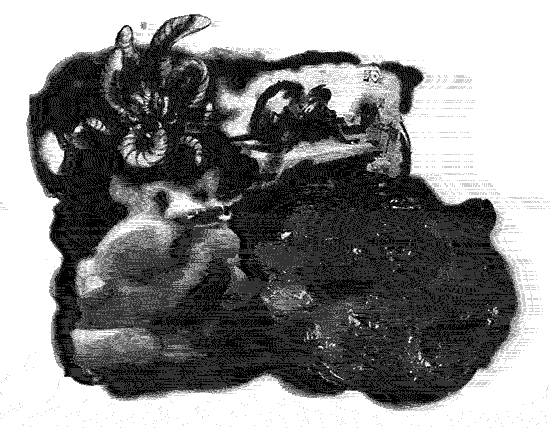
This scenario also requires a younger male character as stand-in (non)-fuck decoy phallus – a virtualisation of Willis’s retro-potential sex appeal in the format of a ‘younger’ penis-model but non-threatening and undeployed. That is, in Freudian terminology: ‘My dick is not (DIE) HARD enough (to fuck my daughter) and therefore I pass my symbolic baton on to you.’
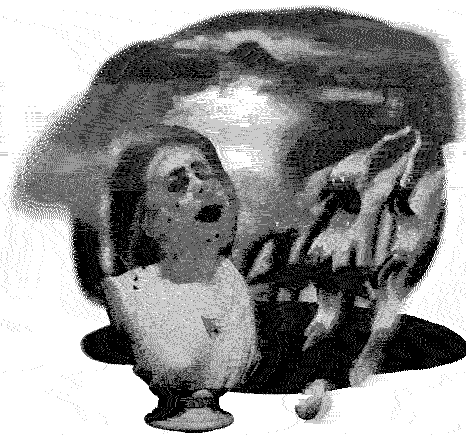

This exchange is suspended in the figure of the younger male lead as doe-eyed, fantasy-baby, soft-on man-cherub as marker holding open the space (or place) for Willis’s fantasy rigid-designator as lost object and symbol of erect verticality. Impossible potential is mirrored by possible (non)potential. And the female lead in the role of ‘the person who could be fucked’ as a stand-in for our own viewer position. A place or hole that can be occupied, as in Irigaray’s description of ‘woman as a place for man’. After all we all want to be fucked by Bruce Willis. Baby-penis, Man-Father, penis-stool, envelope-sheath. The Fantasy is available to us all in a spectacle of scale. There is no false consciousness. [10]
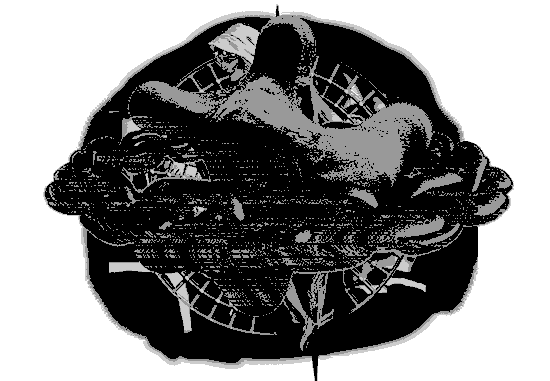

And so if, for example, you are a soldier holed up in a cellar somewhere and you hear the rumble of tanks. And you are singing a few songs with other people to keep your spirits up – some kind of political or religious bullshit. And the sound of the tanks gets near. And then there are some shouts and a bomb comes bouncing down the stairs. And blows your skin and flesh all over the walls. Then this is called HISTORY and OBLIVION. History structured by the ‘politics of disposability’. As a kind of abstraction. And you have just been ABSTRACTED.
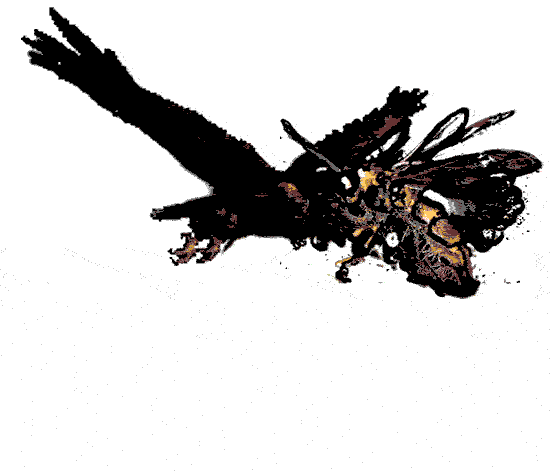
Or if you are lying underneath the ruins of a factory that collapsed on top of you while you were working, because it was built cheaply so as not to eat into profits.[11] Or if you are working in a deep-space call-centre and mining facility which splits its seams, after a reactor malfunction, spewing flesh and hardware across the void.[12] Or for instance, if you were crushed to death by hundreds of boxes of chocolate. And you tried to attract attention but every time you shouted ‘The Milky Bars are on me’ people just cheered, then you have just been LOVED by the mechanism.[13]
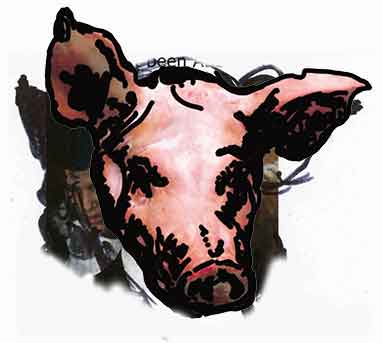
And when the worms find your body under the rubble and turn your body back to chemicals. As a return to the molecular.[14] Back to the universe. Back to NOTHING. Visible and not-visible. As the ultimate expression of sovereignty as ‘the power and the capacity to dictate who may live and who must die’.[15] Or who can be left to die (who can be forgotten). NOTHING as the necropolitical, at once ‘above’ and ‘below’ the scale of the human being. But traced back to real exploitation, to the economy and primitive accumulation. Actual real, unimportant examples of exploitation and oppression. Then you’ve just met MUMMY. And she loves you.[16]
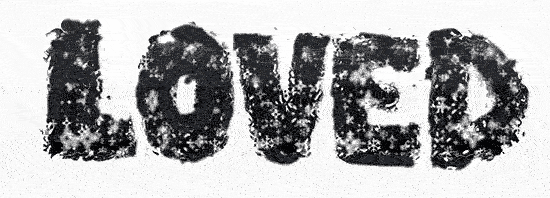

In Elizabethan slang, ‘nothing’ was a term for the female genitalia, as in the title Much Ado About Nothing. To Hamlet, then, ‘nothing’ is what lies between Ophelia’s legs, for, in the male visual system of representation and desire, women’s sexual organs, as Irigaray puts it, ‘represent the horror of having nothing to see.’ When Ophelia is mad, Gertrude says that ‘Her speech is nothing,’ mere ‘unshaped use.’ Ophelia’s speech thus represents the horror of having nothing to say in the public terms defined by the court. Deprived of thought, sexuality, language, Ophelia’s story becomes the Story of O – the story of ZERO.’[17]
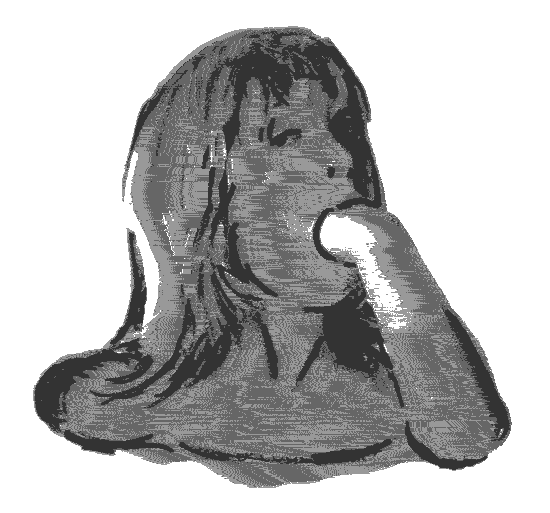
In Aristotle’s terms, according to Irigaray, the intelligible order (eidos) actuallised by form is divine. The deity (theos) is the highest being in his metaphysics, and it is the only being uncontaminated by matter and occupying no place in other words, the deity is pure actuality and does not suffer the changes and the destructions characteristic of artifacts and things that come to be in the real world.[18] Articulated in sexual/sexuated terms – matter desires actualisation. At the very moment that matter is presented as defective – because it is merely a potential substance, characterised by privation – it is related to the feminine. ‘You might say that it [matter] yearns [for form] as the female for the male and as the base for the beautiful.’[19]
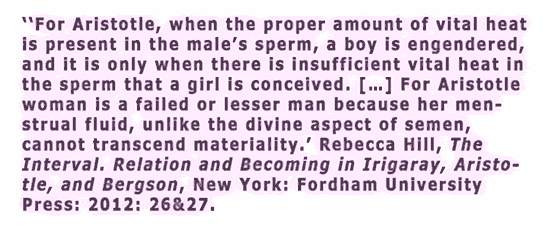
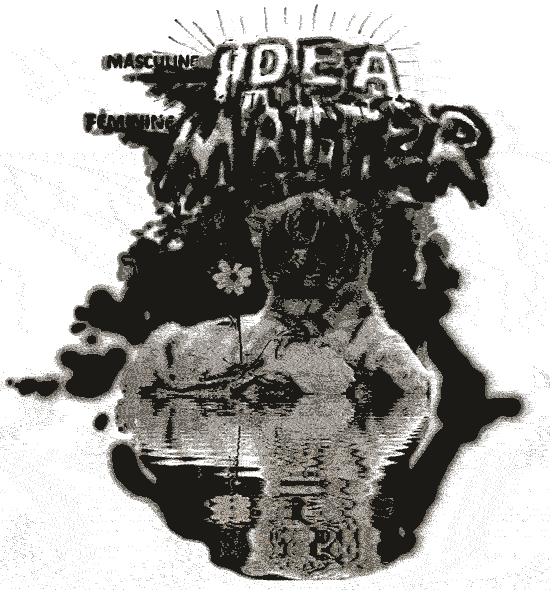
Infected by parasitic fungi, the ant stumbles out of its colony, its ant-head guided by a pathogen to a precise location in the forest. It climbs a plant and sinks its mandibles into the main vein of a leaf selected for its specific height and orientation. Once anchored it dies, and from the back of its head erupts a stalk, which, ‘while in a way […] quite beautiful, might be considered the world’s least desirable hat’.[20] This in turn rains spores down onto the ant’s fellow workers below, attaching to their exoskeletons. And the cycle begins again.
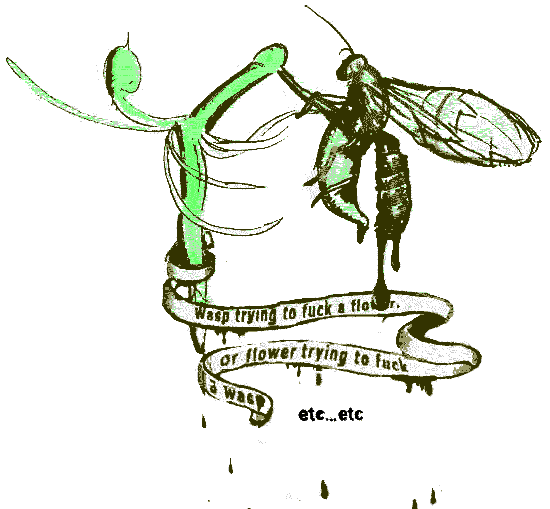
Benedict Singleton writes that ‘it is less use to the trapped to decide upon some holy condition of freedom’ than to ‘understand how one is implicated in the mechanism of one’s entrapment’. To engage in the former ‘is mere escapism’. But if hunting traps are ‘lethal parodies’ of their prey’s behavior. And the design of traps is a strategy that makes use of ‘observed disposition,’ for instance the ‘inclination to eat certain kinds of food’ in the setting of bait, or even the inclination to understand the 'mechanism of one’s entrapment,’ then obviously a trap might be designed in the way it articulates an ‘escape’ – any type of escape – and the escape from the trap might be the trap: ‘a good snare kills through desperation, strangling the target as it tries to escape’.[21] The trap is the trap.

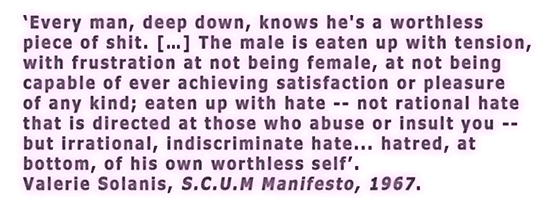
Aristotle’s theorising of ‘place’ and selection of the model of ‘topos’ as a lynchpin of his philosophical system,[22] develops from his characterisation of the ‘womb’ as the primary example of place, whereby ‘thing’ (masculine) and place (feminine) are gendered hierarchically: ‘Irigaray emphasizes that the relationship between woman’s function as a dwelling for the embryo and her vagina’s figuration as a place for the man’s penis are not discrete’.[23] This is replayed as a phallo-nostalgic tragedy, where man yearns to return to the Mother's body, whilst at the same time (dis)locating his origin away from the corporeal (from matter): ‘In all his creations, all his works, man always seems to neglect thinking of himself as flesh, as one who has received his body as that primary home…’[24] In this sense, the vagina, according to Irigaray, functions as a ‘perforation’ toward this ‘first place’ as coffin or tomb.[25] But at the same time female sexual and reproductive functions furnish the system with the concept-metaphors to define place as immobile, in order to give limits to ‘Man and to his things’.[26] Everything in its place. Or placed.


And so we may look to the skies, squinting upwards like Plato’s philosophers escaped from the deceptive materialities of the womb-cave, blinking up at the divine immateriality of the sun and the ‘good’ as the dream-destiny of mankind and the ‘greatest ideas of our civilisation’.[27] Delineating the vertical axis of patriarchy, as the Father of form – the 'progressive erection that goes from quadruped to Homo-erectus.’[28] As a phallus spurting out cum at the sky. As a Fantasy-outside or excess coordinate articulated as both an ‘escape’ from Capitalism (as transcendence, Light, Knowledge, Enlightenment, Truth), and, at the same time, as part of its mechanisms of expansion, as described, for instance, in Rosa Luxemburg’s analysis where capitalism always needs a periphery, a non-capitalist outside to appropriate: new land, new resources, new investment opportunities.[29] This figures space exploration as the export of our retarded and deadly social relations across the galaxy like the escaping monsters in The Thing or Alien – ‘carriers’ of our diseased archaic structurings of time and place.[30] The expansion, militarisation, marketisation, flexibilisation of the Cosmos.
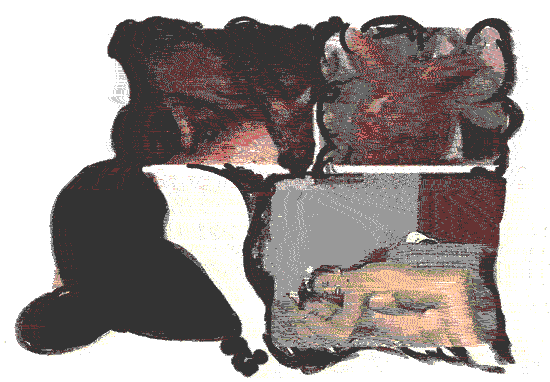

Or this can be reversed around as a parasiting of the present by the future. Ray Brassier, in a recent discussion on JG Ballard’s short story, ‘The Voices of Time’, described the disjunction between adaptation for the future and being in the present: Ballard’s story revolves around an apocalypse, where ‘Time’ is coming to an end; in response, a number of animals begin undergoing strange morphological changes, rapidly evolving to meet a future rushing towards them (a spider that weaves its own neural net outside of its body, a toad with a lead shell, an anemone that hears light). Brassier regards these as examples of the ‘future’s maladaptation to the present’. In Brassier’s analysis this moment is catastrophic[31] – the introduction of a necessary trauma as adaption or orientation towards the future. He describes this as a rehabilitated Prometheanism or enlightened catastrophism where we grasp our destiny in the admittedly corporate/capitalist technologies of advanced science and its applications, for instance, Space Travel.[32] As he describes we have to do something with Time because ‘we know time will do something with us’. The problem here is the brief mention that we should 'refunction' or 'repurpose' the technologies of capitalistic production to 'emancipatory ends'. This is obviously the difficult bit. [33]
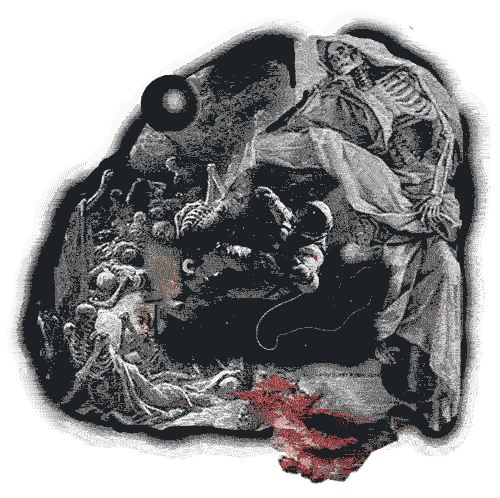
Mickey Mouse, Barack Obama, Justin Timberlake, or Nicki Minaj are sitting in a car – flicking their eyes up at the rear view mirror – they move the car forward a few feet to get a better angle to reverse – the view is partly obscured – thinking about what they have to do that day, the events that will unfold in the next few hours – they reverse the car – there is a nasty crunching sound – suspended nauseously between past and future – and they know they’ve just run over next door’s one year old child who has crawled out onto the drive. The emotion of terror/sickness/wonder reminds them of […]

This is reminiscent of the avant-garde aesthetic (trauma) where our experience of experimentation with the configurations of form and space, in the example of an actual object, for instance a cubist painting (the manipulation of materials, colour, planes and so on) predicts future spatial and temporal configurations and radically transformed conditions of experience. An actualisation of the future in the present moment, as a prophecy or promise, of the forthcoming transformation (or not) of relations of exchange between humans, objects and places including (potentially) the transformation of political systems and redistribution of the means of production. In extension, this is played out affectively, as a kind of terror-aesthetic where these proposed transformations predict our own absence or erasure in the sublime of human potential – that is, the modes of experience which make and construct us as humans would now be incomprehensible to us and us to them.[34] At worst a personalised, 'correlationist' bourgeois histrionics (horror vacui).[35]


But if this is viewed from a Deleuzian/Bergsonian perspective – vitalist image of ‘the ‘force of life’ as difference – as the excessive drive to differ – set against the force of repetition of the same, on both human and cosmic scales.[36] As Elizabeth Grosz describes it, through her Irigarayan/Bergsonian analysis of Darwin, as the expression of freedom tied to the capabilities of our own transformable/ transforming bodies telescoping back through the multi-millenial, material, cosmic-queering of life from the bacterial through to the excessive animal-aesthetics of sexual selection. In the extravagant plummage of birds, the decadence of mating ritual and the frenzied dance of bees, then this aesthetic or affect can be splayed out as an oscillation between the ludicrous and the operational, form and informe, possible and impossible, drama and melodrama, present and the future. And always the stratification of or movement between revolution (including social revolution) and banality – potentially revolutionary as well as potentially trivial. Like a gif.[37] A NOTHING as mediation with the future, where mimicry and sophistry operate as the play of the ‘given’ and the ‘made’.[38]
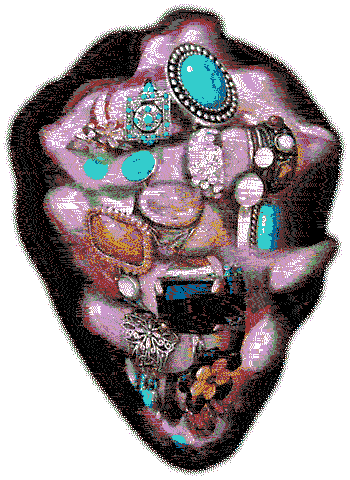
There’s an ‘I’ and a ‘U’ in LUVIN.
Or to return to the idea of the trap which Elizabeth Grosz discusses with reference to the work of the biologist Jacob von Uexkull who describes the development of fly and spider (in terms similar to Singleton) as a kind of ‘mutual adaption’ or ‘harmonic coordination’ where the spider’s web exists as ‘a kind spatial counterpoint to the movements of the fly’. The fly is ‘already mapped, signaled, its place accommodated [bodily/spatially] in, for example, its inability to see the smooth unmoving threads of the web’.[39] Given this structure, one of the ways the fly might escape is to not be a fly. The exceptional thing here is not only to escape the trap but to express a freedom as other to the logic of the trap. That is, to change the rules of the game. And the conditions which create the spider and the fly. This is the production of an aesthetics which is always concerned with affective experience of ontological force, as a virtual and material force of transformation acting in and on the actual drives and flesh of our bodies, as they exist now (positioned by class, race and sexual/sexuated relation) and as they have transformed over Time. [40] Which is why aesthetics is like sci-fi and why Outer Space is so important to aesthetics and politics.
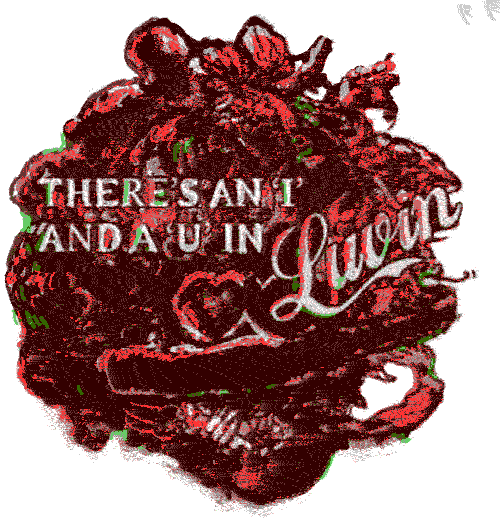
Sub-troped as post-alien category 7/humanoid, deep space cleansing operative 7S1A/Amboina, including tentacle attachments and penis-vagina refurb, moving across the blackness – galaxy reflected in her visor. Meat suit with bio implants. Rotating above Entrance hatch x117. She sprouts wings at her sides. Golden scales reflecting bright white. As an intensity of mimicry and acting out of the cadavers of place. Miming mime itself. Gliding upwards. An angel. As a movement across the material and the divine. As both. The space between.
John Russell is an artist living and working in London, http://www.john-russell.com This text was written to accompany the exhibition AQUARIUM PROLETARIUM at MOT International London, 12 December - 31 January 2015
FOOTNOTES
1. Georges Bataille, ‘The Pineal Eye’, in Visions of Excess. Selected Writings, 1927-1939, Minneapolis: University of Minnesota Press, 2008, pp. 85-6.
2. Irigaray, Luce, Speculum of the Other Woman (1974), Ithaca/NY: Cornell University Press, 1985, p.26.
3. There have been regular criticisms of Luce Irigaray's writing as heteronormative and/or biological essentialism (in particular in 1980s and ’90s), for instance Judith Butler's comments in Diacritics 28/1, (1998), pp.27-28. For a survey of these criticisms, see Margaret Whitford, Luce Irigaray. Philosophy in the Feminine, Routledge: London, (1991), pp.9-25 . As Naomi Schor writes (paraphrasing Whitford's description of Irigaray's 'strategic essentialism') '... mimeticism is the strategy, essentialism is the stage [...] as a philosopher in the feminine Irigaray is obliged not only to pass through essentialism but also to speak its language.' (In 'Previous Engagements. The Receptions of Irigaray', ed.s, Burke, Schor and Whitford, Engaging with Irigaray, Columbia Univ. Press, (1994), pp.11-12. Irigaray locates sexual difference in context of patriarchy as structuring force. Also see: bell hooks, 'Understanding Patriarchy', http://imaginenoborders.org/ pdf/zines/UnderstandingPatriarchy.pdf
4. Irigaray, Luce, Speculum of the Other Woman (1974), Ithaca/NY: Cornell University Press, 1985, p. 89.
5. Youtube: Operación de pene a vagina, 2011.https://www.youtube.com/ watch?v=wCigVyJBZus
6. William Beebe, Edge of the Jungle, 1921. http://www.youtube.com/ watch?v=WxLDin3vYUs.
7. Sky Broadband Unlimited Advert with Bruce Willis, 2013. http://www.youtube.com/ watch?v=9ehtYUYxVrM
8. 2001: A Space Odyssey, 1968 (Dir. Stanley Kubrick).
9. Benedict Singleton, ‘Maximum Jailbreak’, e-flux journal, #46, June 2013 http://www.e-flux.com/journal/maximum-jailbreak/ Those ‘who point to the huge expanse of the earth and the whole terrestrial history of life – this is nothing but myopia, squalid provincialism'. As if the choice was between shiny-suited utopia and some hippy smoking spliffs and talking about dolphins.
10. I have to admit I would like to be fucked by Bruce Willis. Luce Irigaray, An Ethics of Sexual Difference, Ithaca, New York: Cornell University Press, p.35.
11. 'Bangladesh garment factory fire kills 10 people,’ Associated Press, Oct. 9, 2013
http://www.apnewsarchive.com/2013/Fire-at-Banglade...
Working classes to be moved underground: Daily Mirror, August 19 2014. http://www.mirror.co.uk/news/uk-news/social-cleans...
12. Following the capitalisation of outer space, the mass exportation of the poor and dispossessed to deep space live-work factory units and call centres becomes common-place - far beyond the terrestrial reach of labour and health and safety regulations.
13. Catchphrase from British TV advert for Nestlé Milky Bar:
https://www.youtube.com/watch?v= muJDv6Do124
14. This is the affect of ‘Radical Bewilderment’ as the move to ‘molecularity’ in context of culture, politics, social relations whatever, where matter, as ‘particulate’ becomes a kind of sublime miniature [or ‘whatever-vastness’], and the blooming of ‘ontological wonder’ separates ‘the space of rapture from questions of ‘commitment, collective struggle, utopia.’ Jordana Rosenberg, ‘The Molecularization of Sexuality: On Some Primitivisms of the Present’, Theory & Event 17.2 (2014), Project MUSE.
15. Achille Mbembe, ‘Necropolitics,’ in Public Culture, Winter, 15(1), 2003, 11-40: 11.
16. 'After all ‘we are all still cunts,’ Silvia Federici, 'Wages Against Housework', Power of Women Collective and Falling Wall Press, 1975: http://caringlabor.wordpress.com 2010/09/15/silvia-federici-wages-against-housework/
17. ‘Reproductive’ or ‘domestic’ labour is not conventionally (socially) validated as ‘waged’ labour, nor clearly accounted for in Marx’s Capital – that is, the process of transforming Marx’s ‘basket of commodities’ into labour-power. See Gayle Rubin, ‘The Traffic in Women. Notes on the “Political Economy” of Sex’, in Towards an Anthropology of Women, NY: Monthly View Press, 1975. This labour is essential to capitalist production but invisible in its accounting. ‘These are the non-social of the social, the non-labour of labour. They are cut off from social production; they must not only appear as, but also be non-labour, that is, they are naturalised. They constitute a sphere whose dissociation is necessary to make the production of value possible: the gendered sphere’. ‘The Logic of Gender’, Endnotes, #3, September 2013. http://endnotes.org.uk/en/ endnotes-the-logic-of-gender
18. 'The emergence of the intelligible ideas as a standard of truth depends upon the reduction of feminine materiality to inert matter, whose constitutive exclusion sustains the intelligible by suppressing an alternative standard and serving as the ground upon which the progression to the intelligible world occurs,’ Anne Caldwell, 'Transforming Sacrifice: Irigaray and the Politics of Sexual Difference', Hypatia, Vol. 17, No. 4 (Autumn, 2002), pp.16-38, esp. p.18. And therefore the material, changeable, base, finite, dirty, sinful (feminine/female) is differentiated from the eternal/immutable/pure/ divine/immaterial (masculine/ male). These kinds of structures are emphasised by Irigaray as underpinning the 'greatest ideas of our civilization.’
19. Rebecca Hill, The Interval. Relation and Becoming in Irigaray, Aristotle, and Bergson, New York: Fordham University Press: 2012, p.26.
20. Matt Simon, ‘The Zombie Ant and the Fungus That Controls Its Mind', Wired, Sept. 2013. http://www.insidetasmania.com/ p/weird-news.html
21. Benedict Singleton, ‘Maximum Jailbreak’, e-flux journal, #46, June 2013 http://www.e-flux.com/journal/maximum-jailbreak/
22. In Physics, 4.1-5, Aristotle considers the potential of four models for the concept of ‘place’: form, matter, interval and the first immobile limit surrounding a body. He rejects the first three in favour of the fourth thus grounding his philosophy in a structure of immobile places. See, Rebecca Hill, The Interval. Relation and Becoming in Irigaray, Aristotle, and Bergson, pp. 37-54.
23. Rebecca Hill, The Interval, p.59. See also p.57: ‘Man’s body is entangled in Aristotle’s conception of a thing, (not matter) and woman’s body is bound up in his concept of topos (place)'. This is presented as uncontroversial/ neutral; and Irigaray claims these metaphors repeat throughout the history of philosophy and culture, instantiated in our 'commonsensical' ideas of time and space. For instance, her interpretation of Plato's parable where the philosophers escape from the cave (womb) and seek the vertical purity of origin/Truth in the immateriality of the Sun/Light.
24. Luce Irigaray, An Ethics of Sexual Difference, Ithaca, New York: Cornell University Press, pp.127-8.
25. Luce Irigaray, An Ethics of Sexual Difference, Ithaca, New York: Cornell University Press, p.41
26. Rebecca Hill, The Interval, pp.59-60.
27. Shulamith Firestone claims: ‘Of all feminist theorists De Beauvoir is the most comprehensive and far-reaching, relating feminism to the best ideas in our culture.’ Shulamith Firestone, The Dialectic of Sex: The Case for Feminist Revolution, New York: Bantam, p.7. Luce Irigaray writing a few years later suggests that it’s the ‘best ideas’ that are the problem.
28. Georges Bataille, ‘The Pineal Eye’, in Visions of Excess. Selected Writings, 1927-1939, Minneapolis: University of Minnesota Press, 2008, p.87.
29. Rosa Luxemburg, The Accumulation of Capital, 1913: https://www.marxists.org/ archive/luxemburg/1913/ accumulation-capital/accumulation.pdf.
In more contemporary contexts, David Harvey suggests that the world capitalist system needs to find $1.5tn profitable investment opportunities today in order to keep growing at its historical average of 3 percent a year – and $3tn by 2030. From David Harvey, ‘The Enigma of Capital and the Crisis this Time’ (paper prepared for the American Sociological Association Meetings in Atlanta, 2010): http://davidharvey.org/2010/08/the-enigma-of-capit...
30. Under Article II of the 1967 ‘United Nations Outer Space Treaty’, the whole of outer space ‘is not subject to national appropriation by claim of sovereignty, by means of use or occupation, or by any other means’. But lawyers promoting the extension of the private sector into outer space now claim that the framers of the UN Outer Space Treaty '... were deliberately ambiguous about private property as opposed to nationally owned property’. And that ‘the settling of space – including the establishment of permanent settlements on the Moon and Mars – will bring incalculable economic and social benefits to all nations’. Therefore 'sufficient profits must be guaranteed, and this can only be done by ensuring property rights in space'. Peter Dickens, ‘The Humanization of the Cosmos – To What End?’, Monthly Review, Volume 62, Issue 06, 2010. https://monthlyreview.org/2010/11/ 01/the-humanization-of-the-cosmos-to-what-end/#en70
31. In Brassier’s analysis the actualisation of the future in the present moment is catastrophic as the introduction of a necessary trauma, because the future always requires adaptation. Brassier suggests that we orient ourselves towards the production and logic of catastrophe, so that we may become masters of trauma and seize the future. An enlightened catastrophism and rehabilitation of prometheanism, as the claim that there are no predetermined limits of what we can achieve or limits on how or what we can become. That we ‘…should try and do something with time, given that time will try to do something to us.’ This requires the acknowledgement that ‘…the way we understand the world and the way we change the world based on that understanding is continually transforming’. Ray Brassier, EXPO 1: NEW YORK, MoMA PS1, 19 July 2013: http://www.momaps1.org/expo1/event/raymond-brassier/
32. Likewise Benedict Singleton steers clear of describing how space travel is wrested from capitalist control, although he describes the ‘irreducibility of design to stated motivations of capital interest, social progress or scientific advance’, proposing a scenario where freedom is quantitative, ‘proceeding by degree – we are free of this, and then of this, and then of this’, new end points emerging in process ‘rather than an a priori finish line […]’. Benedict Singleton, ‘Maximum Jailbreak’, ACCELERATE. The Accelerationist Reader, Falmouth/Berlin: Urbanomic, 2014, pp.489-507.
33. Ray Brassier, ‘Prometheanism and its critics’, in (ed.s) McKay, R. and Avanessian, A., ACCELERATE. The Accelerationist Reader, Falmouth/Berlin: Urbanomic, 2014, p.469.
34. For instance, Robert Neville, as the last human in Richard Matheson’s , I am Legend, 1954. Or Marx’s conception of species-being: ‘It is therefore in his fashioning of the objective that man really proves himself to be a species-being. Such production is his active species-life. Through it nature appears as his work and his reality. The object of labour is therefore the objectification of the species-life of man: for man reproduces himself not only intellectually, in his consciousness, but actively and actually, and he can therefore contemplate himself in a world he himself has created. In tearing away the object of his production from man, estranged labour therefore tears away from him his species-life, his true species-objectivity, and transforms his advantage over animals into the disadvantage that his inorganic body, nature, is taken from him.’ Karl Marx, 'Economic and Philosophical Manuscripts' (1844) in Karl Marx, Early Writings, New York: Vintage Books, p.197, p.329. For instance, Irigaray proposes a transformation of the symbolic/imaginary, as an ontology of ‘at least two sets of forces, two kinds of processes, two relations to the world’, as opposed to a tracking back to the one. Cosmonauts therefore require a ‘from-birth’ re-education as a way of reformatting our retarded social relations and conceptions of time and space: ‘The transition to a new age requires a change in our perception and conception of space-time, the inhabiting of places and of containers and envelopes of identity’. Luce Irigaray, An Ethics of Sexual Difference, Ithaca, New York: Cornell University Press, p.7.
35. Horror or 'wonder'. ‘When the first encounter with some object surprises us, and we judge it to be new or very different from what we formerly knew, or from what we supposed that it ought to be, that causes us to wonder and be surprised; and because that may happen before we in any way know whether this object is agreeable to us or is not so, it appears to me that wonder is the first of all the passions’. René Descartes, ‘The Passions of the Soul’, article 53. Quoted in Irigaray, Luce Irigaray, An Ethics of Sexual Difference, Ithaca, New York: Cornell University Press, p.13.
36. ‘See I had this theory once … I believed in the politics of Saturday night … I rated all governments and countries by how good or bad their Saturday nights were and I knew that Moscow and Peking had to be a stone drag at that time of the week … so I was fighting for a cause … I was fighting to defend chicken barbecues and weenie roasts and Ray Charles songs and drinking Southern Comfort till you pass out behind the bar…’ Mel Gibson, Air America, 1990. Also see Elizabeth Grosz's description of the 'repetition of matter', Elizabeth Grosz, Becoming Undone, Darwinian Reflections on Life, Politics, and Art, Durham &London: Duke University Press, 2011, pp.52-54.
37. In the sense of the 'dialectical image', that is, the dynamic force of ‘images charged with movement’ as in Benjamin’s structuring of messianic time, where the fleeting appearance (movement) of the dialectical image invokes action, animated philosophically and politically by its impermanence and movement. Or for instance as Bataille writes, in ‘Nietzsche’s Laughter’, pp.18-19, the possible exists at ‘the limit of the impossible.’ ‘The possible and the impossible are both in the world. We are troubled by the sky, the starry space in which we discover the laws of harmony, general viability. In this domain we can have a presentiment of suspended horror, ungraspable to us. But we have a precise knowledge of our terrestrial domain that comes from the possible and the impossible. The possible is organic life and its development in a favourable setting. The impossible is the final death, the necessity of destruction for existence. This at least is irreducible: human conduct adds the exuberance of cruelty, useless disorders, war, torture, oppression, vice, prostitution, alcoholism, and, in the end, the multiple horrors of misery.’
38. Discussing the relationship between the organism and its surroundings Roger Callois describes the operations of camouflage where ‘resemblance is therefore obtained by the sum of a certain number of small details, each of which has nothing exceptional about it and can be found isolated in neighbouring species, but whose combination produces an extraordinary imitation of a dry leaf’. Later he writes: ‘Mimicry is an excess or dangerous luxury for instance the case of the Phyllia who eat each other ‘taking each other for real leaves … the simulation of the leaf being a provocation to cannibalism … The search for the similar would seem to be a means, if not an intermediate stage. Indeed, the end would appear to be assimilation to the surroundings.’ Roger Caillois, ‘Mimicry and Legendary Psychasthenia’ (1935), October 31, 1984, pp.12-32, especially p.23, p.25 and p.27.
Irigaray describes mimicry as: ‘[a]n interim strategy for dealing with the realm of discourse (where the speaking subject is posited as masculine), in which the woman deliberately assumes the feminine style and posture assigned to her within this discourse in order to uncover the mechanisms by which it exploits her’, Luce Irigaray, This Sex Which Is Not One, p.221. As Elizabeth Grosz puts it ‘Irigaray mimics the hysteric’s mimicry. She mimes mime itself.’ Elizabeth Grosz, Sexual Subversions: Three French Feminists, St. Leonards: Allen & Unwin, (1989), p.136. Irigaray’s mimicry is both ‘…terroristic and terrorized’ Dianne Chisholm, `Irigaray's Hysteria', in Carolyn Burke, Naomi Schor and Margaret Whitford, Engaging with Irigaray, New York:Columbia Press, pp.263-283, esp. p.269.
39. Elizabeth Grosz, Becoming Undone, Darwinian Reflections on Life, Politics, and Art, Durham &London: Duke University Press, 2011, pp.180-1.
40. Both Marx and Irigaray propose ontological change as disruption of given and made (as Brassier puts it). For instance what Luce Irigaray proposes as a terrifying but understandable and experienceable ontological transformation (because of the way she connects it to the conditions of our body), is the an ontology of at least two, as opposed to continuously tracking back to ‘The One’ as God or Truth, a structure which she claims underpins Western philosophy/ politics. An ontology which would always include at least two perspectives/positions and is never collapsible back to one. In part the force of this is aesthetic.
Irigaray retrieves one of Aristotle’s rejected models of ‘place,’ that is ‘the interval’ – the space in between – and transforms it from a ‘place’ into a ‘thing’ or substance – always in play – in the same way that mucous or the placenta are conductive materials between things. For instance, Irigaray’s example of mucus as medium of exchange between bodies for the absorption of food, oxygenation, sexual reproduction – as the points at which our bodies exchange matter with what is not our body: mucus ‘serving love, respiration [and] song’. The way the spoken voice requires saliva to occur, as the physical relation becoming social. Or the placenta as a negotiation between the embryo which is part foreign (half of its genes are paternal) and the maternal body. Living tissue that operates during a (roughly consistent) term of pregnancy – the placental relation gestures to the past experience of the Mother, her relations with others and with her milieu, to her own prenatal life within her mother’s body, and to her future, which is unknowable. The embryo is also virtually human – a boy or a girl – with an incalculable future.
Mute Books Orders
For Mute Books distribution contact Anagram Books
contact@anagrambooks.com
For online purchases visit anagrambooks.com

